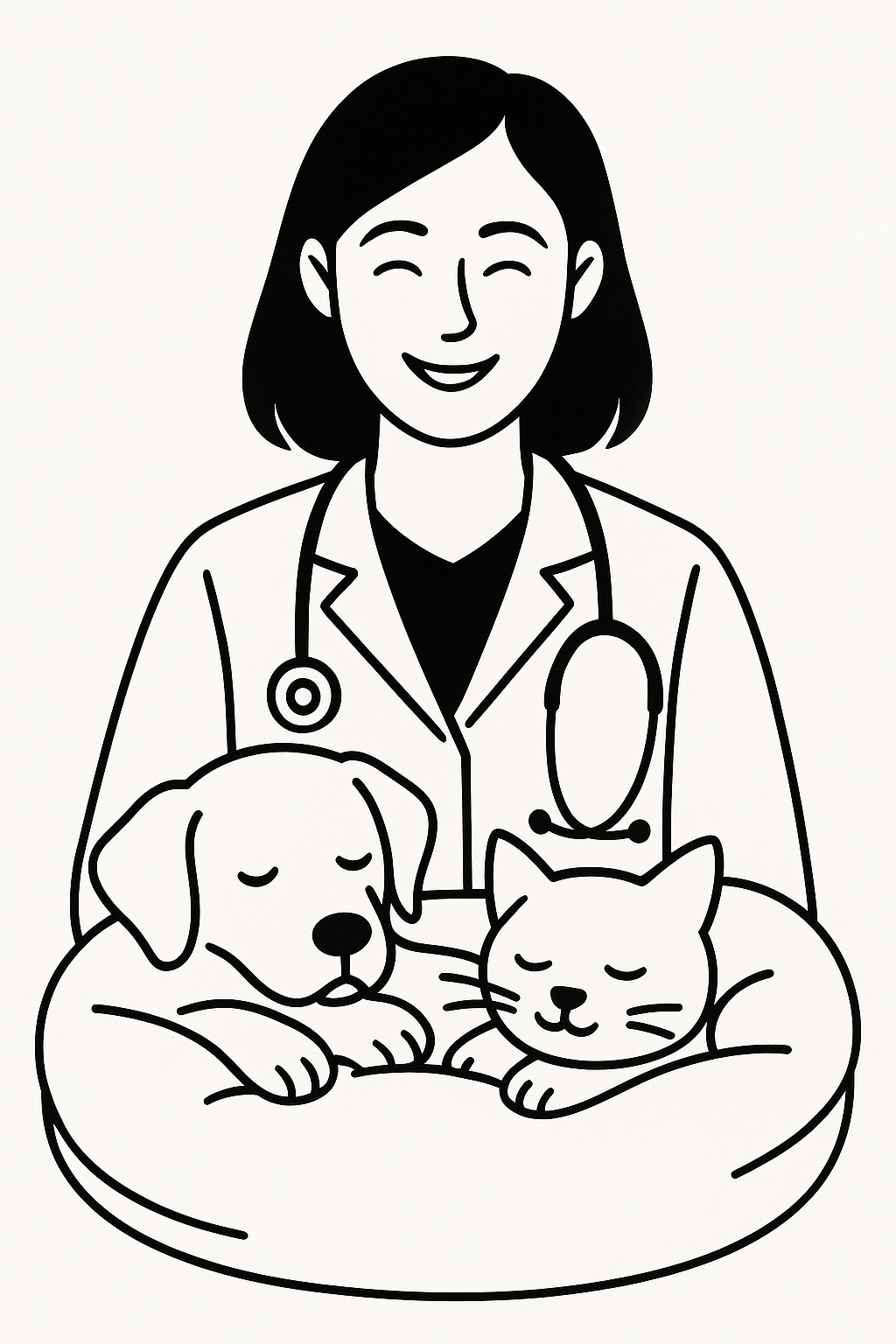As a veterinarian, I often speak about nutrition, exercise, and preventive care. But if there’s one essential component of your pet’s health that remains underestimated, it’s sleep. Just like us, our pets rely on deep, restorative rest for everything from physical recovery to emotional regulation. Yet, far too often, sleep is seen as a passive state—a default, rather than a critical biological need.
Today, I want to share what I’ve learned through years of observation, research, and hands-on experience in both clinical and home environments. It’s my hope that by understanding how your dog or cat sleeps—and why it matters—you’ll not only make more informed decisions as a pet parent, but also build a deeper bond with the animal who trusts you most.

The Nature of Animal Sleep
Sleep is one of the few constants across the animal kingdom. Every mammal, from a lion in the savanna to the dachshund in your living room, must sleep to survive. But unlike humans, whose sleep is consolidated into large nightly blocks, dogs and cats engage in polyphasic sleep—meaning they sleep in multiple short bouts throughout the day and night.
Dogs, for instance, sleep an average of 12 to 14 hours per day, while some breeds—especially puppies and large dogs—may sleep even more. Cats, on the other hand, are masters of sleep, clocking in anywhere from 13 to 18 hours daily. These are not idle moments; they are necessary for memory formation, hormone regulation, tissue repair, and emotional balance. Sleep is, quite literally, healing.
In the clinic, I can often trace behavioral issues, anxiety, or even immune dysfunction back to sleep disruption. When a dog isn’t resting properly, he’s more reactive. When a cat isn’t sleeping well, she may groom excessively or become withdrawn. Sleep, or the lack of it, echoes in every aspect of a pet’s life.
Comfort Is Not a Luxury
One of the most common misconceptions I encounter among pet parents is the belief that pets can—and should—sleep anywhere. “They’re animals,” someone might say. “They don’t need anything fancy.” It’s a well-meaning sentiment, but one that overlooks both biology and emotional intelligence.
Animals seek comfort instinctively. In the wild, dogs would dig a shallow bed in the ground to soften their rest and feel secure. Cats would find high perches or warm dens for napping. These behaviors persist in our homes because the need remains. Comfort isn’t an indulgence. It’s an extension of the animal’s natural survival strategy.
The surface your pet sleeps on matters more than you might think. A bed that is too firm, too thin, or made from irritating materials can cause joint strain, pressure point discomfort, or even overheating. This is especially true for older pets, short-haired breeds, and animals with medical conditions like arthritis, hip dysplasia, or anxiety. When I consult with families about behavioral changes or chronic pain, one of the first things I evaluate is where—and how—the pet is sleeping.
The right bed can relieve tension, encourage deeper sleep cycles, and reduce tossing, scratching, or shifting. More importantly, it can signal to your pet that this space is theirs—a constant, a refuge, a home within your home.
Anxiety and Sleep: A Silent Feedback Loop
If you’ve ever had a sleepless night due to stress, you know how closely tied our emotional and physical states are. The same is true for pets. Anxiety can interfere with sleep, and poor sleep can exacerbate anxiety.
This loop is particularly evident in rescue animals, dogs with a history of neglect, or cats navigating major household changes. Without consistent, peaceful sleep, their nervous systems remain in a low-level state of alertness, making it harder to form routines, build trust, or recover from illness.
In such cases, creating a predictable sleep environment is one of the most powerful things you can do. This means more than placing a bed in the corner. It means choosing a location that is away from heavy foot traffic, selecting textures that feel soothing, and ensuring that their bed retains warmth without overheating. The bed becomes a symbol—not just of sleep, but of safety.
In my experience, pets who feel secure in their resting space are often calmer during storms, better behaved during vet visits, and quicker to settle when visitors arrive. There is a profound emotional component to sleep. It’s not just rest—it’s repair.
Recognizing Poor Sleep in Pets
Unfortunately, because pets can’t tell us they’re not sleeping well, many of the signs go unnoticed or are misinterpreted. A dog who changes positions constantly at night may not be “just restless”—he may be trying to avoid pressure on a sore joint. A cat who suddenly starts napping on hard floors might be avoiding a scratchy or overheated bed.
Some pets will begin sleeping in unusual locations—under the bed, behind the couch, or in laundry baskets—seeking a specific combination of darkness, texture, or scent that soothes them. Others will become more reactive during the day, bark more frequently, or start pacing in the early morning hours. These behaviors are not always signs of bad manners. Often, they are sleep disturbances in disguise.
In older pets, poor sleep may accelerate cognitive decline. You might notice signs like confusion, nighttime wandering, or even vocalization after lights out. In younger pets, disrupted sleep often presents as hyperactivity, digestive upset, or attention-seeking behavior. Once a proper sleep space is reintroduced, many of these symptoms improve.
A Note on Bonding and Bedtime
One of the most beautiful moments I see between pets and their people is when a bedtime ritual begins to form. A dog who trots to their bed after dinner. A cat who waits for a soft blanket to be laid down before curling up. These are more than cute routines—they are signs of a regulated emotional system and a sense of place.
When you invest in your pet’s sleep, you’re doing more than providing comfort. You’re reinforcing trust. You’re showing your dog or cat that their needs are seen and met. Over time, this builds not only better health, but a more secure, emotionally resilient animal.
I’ve had patients who slept better with a certain scent nearby, like an old shirt from their favorite human. Others calmed more quickly when white noise machines were introduced. Some benefited from bolstered beds that allowed them to lean, nest, or curl more naturally. In all cases, the result was the same: calmer mornings, steadier health, and a stronger human-animal bond.
Why I Care
I founded BedsforFloofs not to sell cute beds, but to answer a deeper question: How can I help pets feel more comfortable in their daily lives? After years of treating chronic pain, anxiety, and age-related decline, I realized that while medicine plays an essential role, so do the small, quiet decisions made at home.
Choosing the right bed. Placing it in the right space. Recognizing that your pet’s comfort is not secondary—it’s central.
Every animal who walks into my clinic is an individual with their own story, their own fears, and their own way of feeling safe. What they need isn’t always expensive or complex. Often, it’s something as simple as a good night’s sleep.
In Closing
Your pet may not be able to tell you how much their bed matters. But if you watch closely, you’ll see it. In the way they sigh when they settle. In the way they seek it out when the world feels too loud. In the way they sleep longer, deeper, better when it’s just right.
Sleep is not a luxury. It’s care. And when you choose comfort for your pet, you’re not just making them feel good—you’re helping them live better.
Thank you for taking the time to care,
Dr. Abigail Marrow
Veterinarian & Founder, BedsforFloofs

